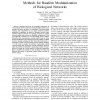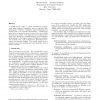270 search results - page 40 / 54 » Hierarchical Model to Develop Component-Based Systems |
BIBE
2006
IEEE
14 years 1 months ago
2006
IEEE
— Biological networks are formalized summaries of our knowledge about interactions among biological system components, like genes, proteins, or metabolites. From their global top...
JCB
2008
13 years 7 months ago
2008
Resolving the general organizational principles that govern the interactions during transcriptional gene regulation has great relevance for understanding disease progression, biof...
PLDI
1998
ACM
13 years 12 months ago
1998
ACM
A module system ought to enable assembly-line programming using separate compilation and an expressive linking language. Separate compilation allows programmers to develop parts o...
HICSS
2005
IEEE
14 years 1 months ago
2005
IEEE
The goal of a Public-Key-Infrastructure (PKI) is to prove whether a cryptographic public key is authentic for a certain user. This information is crucial for the reliability of as...
MMS
2000
13 years 7 months ago
2000
A large-scale, distributed video-on-demand (VOD) system allows geographically dispersed residential and business users to access video services, such as movies and other multimedia...


